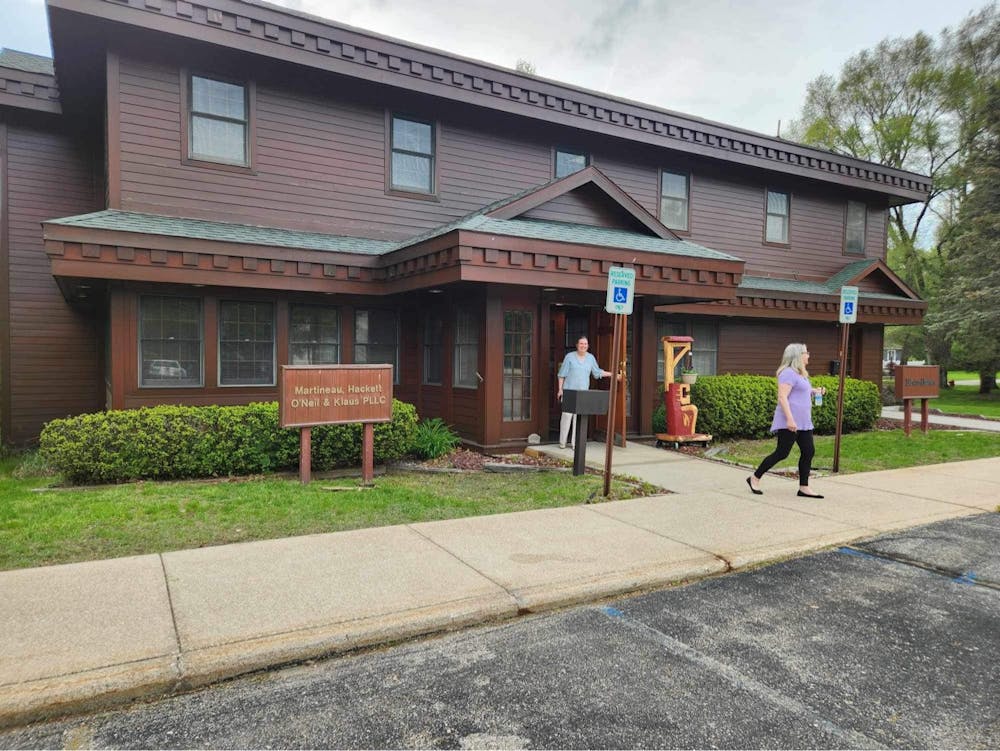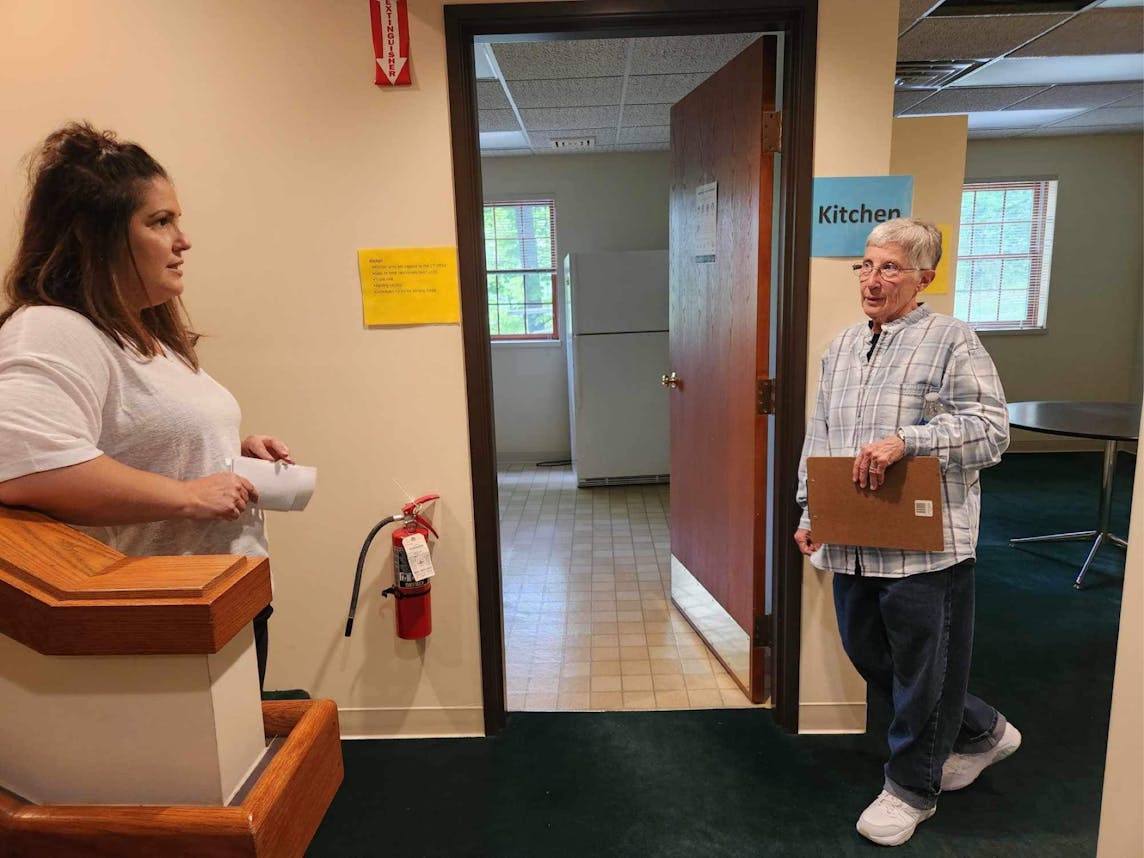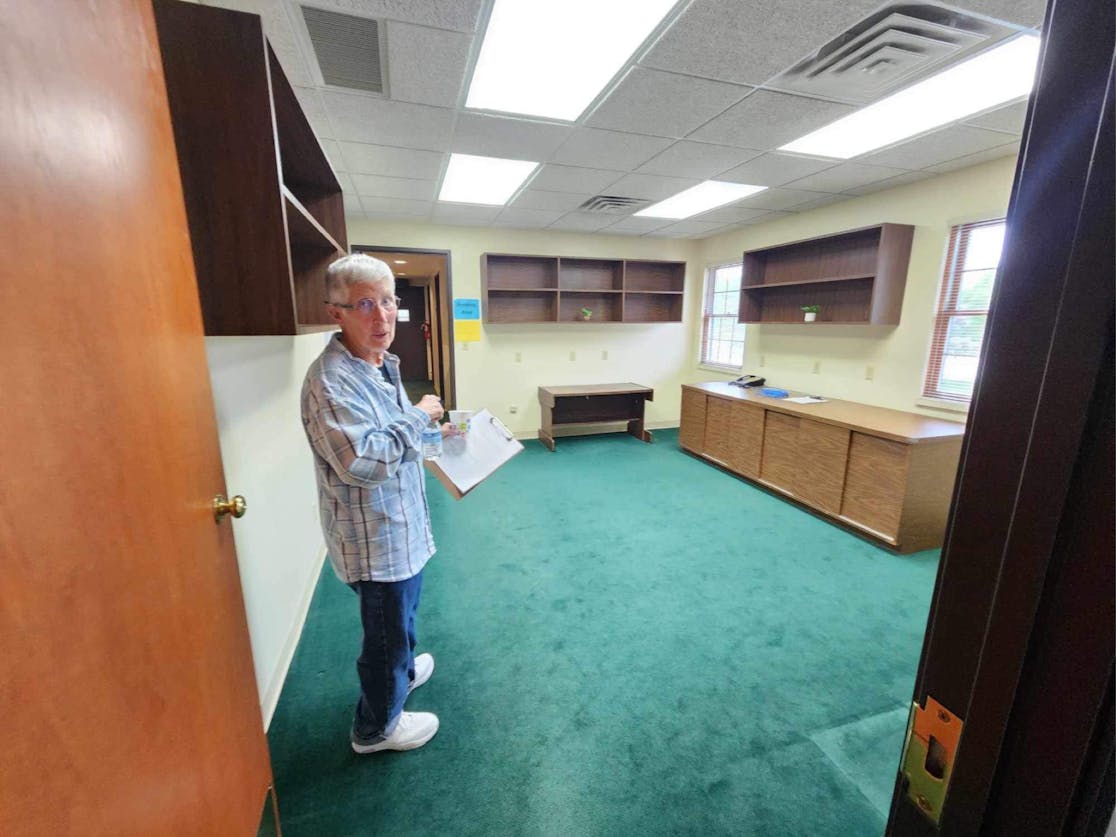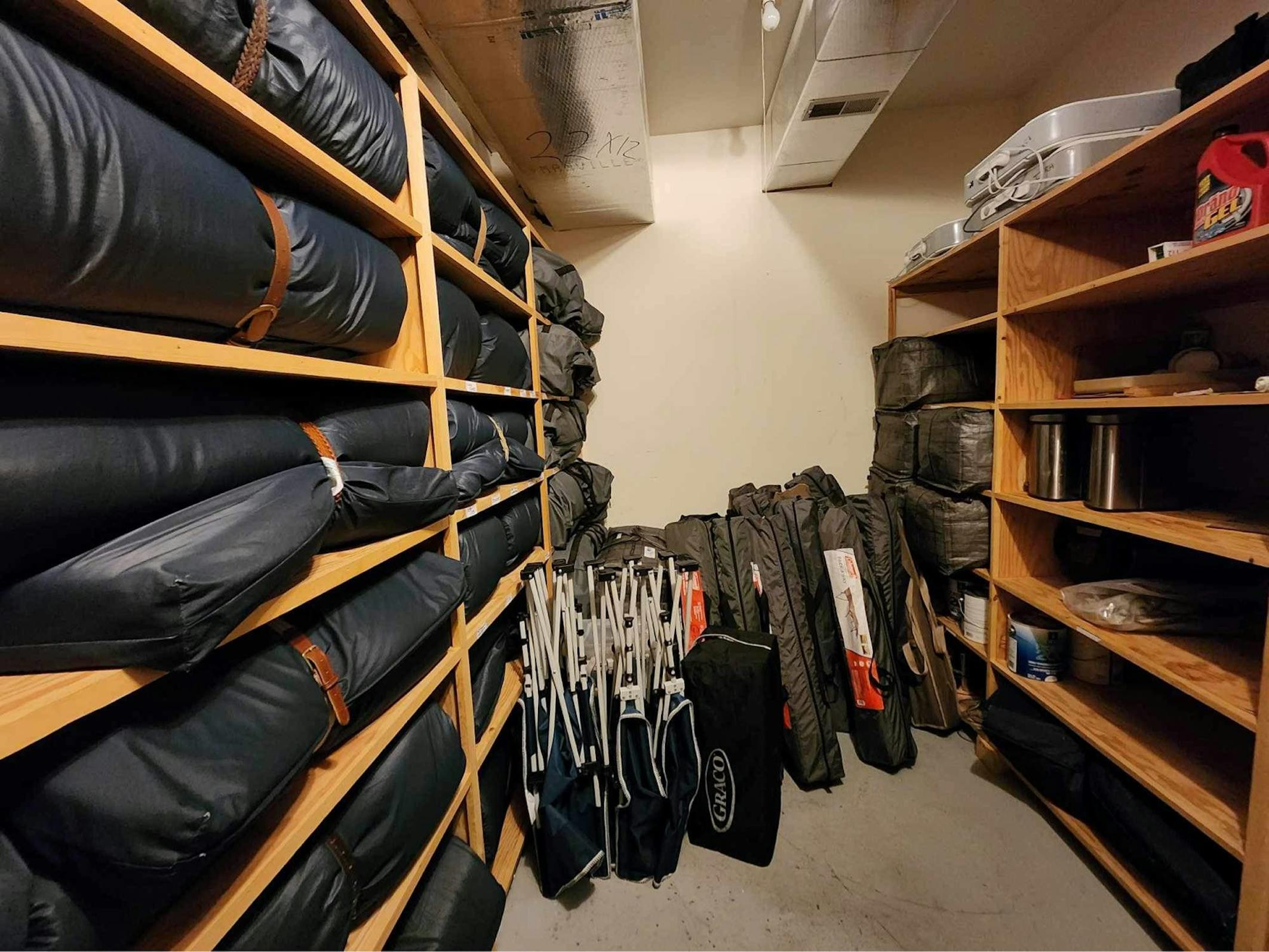A Place to call home
Isabella County Restoration House kicks off campaign for new shelter

Isabella County Restoration House Executive Director Dee Obrecht (left) bids farewell to Executive Assistant Kendra Milton following an open house at the nonprofit’s new building Thursday, May 16, 2024. The facility, located a 555 N. Main St., will be renovated into a 45-person-capacity homeless shelter and day center.
The building at 555 N. Main St. sits back from the roadway separated by a large parking lot and shady trees.
It looks like a chocolate brown take on a Swiss chalet, with ornately carved crown molding along the first and second floors, and windows that provide plenty of natural light for the residents within. Signs out front speak to the financial brokers and legal firm that have historically called the office space home.
On Thursday, a pop-up banner announced a pending change of occupancy. Since November of 2023, this three-story commercial building has belonged to the Isabella County Restoration House.
The nonprofit, which provides services, support and — during the winter months — rotating shelter for the county’s unhomed residents, plans to convert the new property into the county’s first permanent shelter.
Last week, it welcomed supporters and partners to the facility for an open house and to kick off the capital campaign that, staff and board members said, will fund the renovations necessary to open the shelter to the consumers that staff and volunteers refer to as guests.
All that stands between the organization, its Board of Directors, its guests and the permanent vision is just shy of $1 million worth of retrofitting.
“It’s time,” Executive Director Dee Obrecht said, as she stood in the entrance to the building, greeting visitors with a grin on her face. “This is a huge transition and we have a lot to work through, but (we’re) up for it.”
Doorways to stability
At best estimate, some 550 unhomed individuals are living in the region, Obrecht said. That includes roughly 150 school-aged children who are enrolled in public schools, but do not have a permanent address.
“The homeless in our area tend to hide,” Obrecht said. “This year we got more requests … for families.”
During the rotating shelter season, which starts in late October and runs through mid-April, the restoration house provides a safe bed and nutritious meal for between 22 and 25 people on any given night. Partner churches provide the sleeping space and dinner for guests one week at a time, and the Isabella County Soup Kitchen serves breakfasts and lunches.
The Restoration House maintains a day program at its site at 120 Pine St., where clients can access case management services, computers, laundry and shower facilities, locked storage, mailboxes, a play area and WiFi, according to the organization’s website.
The goal is to give guests the support they need to open the door to a self-sustaining life in permanent housing and to close the door on homelessness.
“When people come to use, they are coming into a program,” Obrecht said. “They work with us for 60, 90, 120 days.
“We focus on self-sufficiency. … They’re not just showing up and getting a bed and a meal for the night.”
How to help:
Tax-deductible donations may be made:
* online at icrc.org/donate;
* through mail at 120 S. Pine St., Mount Pleasant, MI, 48858; or
* in-person by stopping by the South Pine Street premises during normal operating hours.
For more information, visit icrchouse.org or icrhouse.org/new-building

Angelina Maney (left), vice president of the Isabella County Restoration House Board of Directors, talks with Board Member Norma Bailey in the basement of the organization’s new building Thursday, May 16, 2024. The nonprofit recently launched a capital campaign to renovate the three-story building into a 24-hour, year-round homeless shelter and services center.
Renovated building, restored dignity
To walk into the space is to walk into a clear vision that has yet to be fulfilled. The three-story building is built into a hill, and every square inch — from the third-floor sleeping quarters to the basement kitchen and classrooms — has a purpose in mind.
In a sun-soaked office on the main floor that will someday serve as the main reception area, board Vice President Angelina Maney enthusiastically explained the plan.
A wall behind her was marked with a large, blue-taped box that will become a window to a common room. She can already see a time when guests are able to relax and watch T.V. while their children play nearby, or duck into a private office to participate in a virtual meeting or interview.
“We were so excited when we got the current day shelter,” Maney said. “I look at a place like this and I’m just so excited!”
This middle floor will serve daytime programming, Obrecht said, providing work and meeting spaces, a children’s play area and a living/relaxing lounge, among others. Downstairs, a common dining area, storage and classrooms will allow guests to share meals, educational programming and communal recreation such as game nights.
The top floor is slated for the overnight hours, and will feature a men’s sleeping area, a women’s sleeping area and two secure family rooms. While the Restoration House team won’t be able to guarantee one family per room, the guests will be rest assured that they will can rest safely, securely and comfortably, both Manley and Obrecht said.

Isabella County Restoration House Board Member Norma Bailey stands in an office that will be renovated into a shared sleeping quarters, as part of a nearly $1 million renovation project turning the space into a 24-hour, year-round homeless shelter. ‘It will be much more of a sense of community,’ she said about the shelter.
A separate entrance will allow guests who work overnight to come and go without disturbing their peers, and for those who do not fall asleep when lights go out, there will be a quiet space on the third floor for reading or scrolling, Obrecht said.
Each floor will have a restroom with shower and secure lockers for storage. The sweeping back yard, which has a small picnic table and views of the Chippewa River, will be surrounded by a privacy fence.
All told, once the building is renovated, it will play host to as many as 45 guests, Obrecht said.
“We’ll be able to double our capacity here,” she said.
The team’s hope is that the cots, camping chairs and sleeping bags that volunteers like Board Member Norma Bailey currently relocate every Sunday during the winter will be retired — or at least relegated — to the basement storage closet in which they will spend the summer.
To Bailey the mission of the work exceeds a meal or bed for the night. Rather, it’s to foster a sense of community, restore dignity and ultimately help guests stabilize so they and their families can be self-sufficient.
She said it is the difference between charity — offering a handout — and justice.
“It isn’t only just that people have a place to stay,” she said. “Justice is how do we change the system? That’s why this is so important.
“We are building life skills for them, and now we’ll be able to do that. How can we help you become all that you can be?”
The hope is to have the facility renovated and ready for guests in time for the start of the winter season, but that’s dependent on how quickly the funds are raised. Isabella County real property records show the sale price was $775,000, and Bailey said the board bought it out-right through a combination of existing funds and a donation from very generous benefactor, who wished to remain anonymous.
“We are so fortunate to get this building,” she said. “Now all of our efforts can go into renovating it.”
* Related content: Unveiling the invisible struggle *

A storage closet in the basement of 555 N. Main St. is jammed with cots, sleeping rolls, camping chairs and other necessities for the Isabella County Restoration House’s rotational shelters. Every Sunday between late October and mid-April, volunteers led by Board Member Norma Bailey move the items from one host church to the next.






